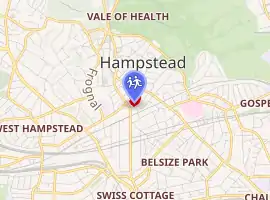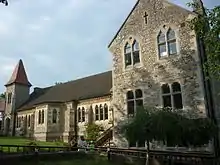Fitzjohn's Primary School
Fitzjohn's Primary School is a community primary school in Hampstead, London. The school was established in 1953. The school took over the school buildings and some of the grounds that were previously part of the estate belonging to the Royal Soldiers' Daughters' Home. There is also a nursery school which opened in 2006. The school is authorised to have a maximum of 230 pupils, including the nursery intake.[1]
| Fitzjohn's Primary School | |
|---|---|
 | |
| Address | |

| |
86A Fitzjohn's Avenue , , NW3 6NP England | |
| Coordinates | 51.5536°N 0.1753°W |
| Information | |
| Type | Community Primary school |
| Established | 1953 |
| Local authority | Camden |
| Department for Education URN | 100026 Tables |
| Ofsted | Reports |
| Headmaster | Rob Earrey |
| Gender | Coeducational |
| Age | 4 to 11 |
| Houses | Air, Earth, Fire and Water |
| Website | http://www.fitzjohns.camden.sch.uk/ |
History
The Royal Soldiers' Daughters' Home was established in 1855 to provide a home and education to daughters of Crimean War veterans.[2] This Victorian institution continued as a home and school until 2012 when it merged with another school.[3]
The post–World War II baby boom resulted on increased pressure on class sizes in the Hampstead area. However despite infant class sizes of up to 60 there was stiff resistance to the establishment of new Primary Schools as set out in the local authority School plan, particularly from other local schools. However, despite this opposition Fitzjohn's Primary School was opened in 1953.[4] It replaced the Soldiers Daughter's Home school and took over the Home's schoolrooms, schoolhouse and chapel.[5] The Home's former school buildings provided classroom accommodation for the infants school. A two-storey building, that was part of the original estate, also became part of the school and was used as an assembly and dining hall. A new single-storey block comprising three classrooms and ancillary buildings was built to accommodate the junior school. Over the first sixty years of the school there have only been five headteachers.[6] The first headteacher of the school was Miss Mandeville. Because of the school's Hampstead location it has benefited from being able to attract well-known figures from the literary world, including the poet Ted Hughes who discussed poetry with a class in the late 1970s.[7]
Present day
The school takes children from just before their fourth birthday until age 11. It is a single entry admission school with a maximum roll of 212, excluding the nursery school which was established in 2006. Classes 1 to 6 follow the National Curriculum.[8] The school, which was rated overall as 'Good' following its last Ofsted inspection in 2009[9] celebrated its 60th Anniversary in June 2013.[8]

Buildings
The Victorian chapel and school buildings were designed by William Munt in a Gothic revival style and was opened by Prince Albert and the Duke of Wellington on 18 June 1858.[10][11] The buildings were constructed using Kentish rag with Bath stone dressings, tiled roof, a two-storey tower with broached spire, with entrance porch to ground floor. It was granted Grade II listed status in 2002.[12] It was adapted for primary school use in 1953 and underwent major refurbishment in 2007, retaining the Victorian features, such as the scissors trusses. It now houses a large school assembly hall, a number of small classrooms, the main school reception and administration block. Reception and infant classes are housed in a modern building constructed in 2006. The three junior school classes occupy the refurbished 1954 school building.[6]
References
- Direct Gov School entry. Retrieved 11 May 2013
- Hampstead Education Establishments British History Online. Retrieved 10 May 2013
- New book celebrates the history of The Royal School Hampstead Ham and high. Retrieved 14 May 2013
- British History Online Hampstead Education. Retrieved 14 May 2013
- Alastair Service Page 33. Phillimore & Co Ltd
- School Prospectus 2011–12 TES. Retrieved 11 May 2013
- Beeson, Lois. (October 1999) [1997]. "An appreciation of Ted Hughes" (PDF). Changing English: Studies in Reading & Culture. Carfax Publishing Company. 6 (2): 187.
- School website. Retrieved 11 May 2013
- Fitzjohn's Primary School Ofsted Inspection Report 2009 Ofsted. Retrieved 11 May 2013
- The Army Children Archive Opening of the Soldiers Daughters Home in 1858. Retrieved 15 May 2013
- The Times Newspaper p.9 Soldiers Daughters Home 19 June 1858 The Times digital Archive. Retrieved 19 May 2013
- Historic England. "Fitzjohn's Primary School (1272435)". National Heritage List for England. Retrieved 11 May 2013.
Further reading
- Ian Dungavell. "Saving our historic primary schools". buildingconservation.com. Retrieved 23 May 2013.
...it is typical of many smaller schools built before the 1870 Education Act, and a good example of gothic revival school design, with trefoil-headed lancet windows in Bath stone set in walls of Kentish rag. The entrance is beneath a two-storey tower with a broach spire, giving a churchy feel often found in parish schools.
- "Fitzjohn's Primary School, London". gohistoric.com. Archived from the original on 29 June 2013. Retrieved 19 May 2013.
The school has an interesting philanthropic history, is a good example of Gothic Revival school design, and retains an impressive interior.
- "Fitzjohn's primary school, London". Elliott Wood, structural and civil engineers. Retrieved 23 May 2013.
The original Victorian Hall which had been subdivided, was opened up to create [a]...spacious hall and library.
- Fitzjohn's primary school, London (33 black and white images from the collection's archive. Photographs were taken between 1953 and 1960 and in 1976 comprising external views of the school buildings and playgrounds:- The 1854 building original school house, classroom and chapel building. Early 20th century gable-ended building containing kitchens and dining / assembly hall. Single storey classroom block built in the early 1950s. Infants and junior school playgrounds.). London Metropolitan Archives and Guildhall Art Gallery 'COLLAGE' – Images Collection. Archived from the original on 4 March 2016. Retrieved 24 May 2013.